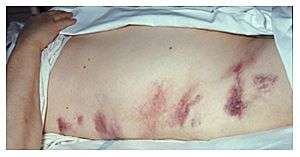Grey Turner's sign
| Grey Turner's sign | |
|---|---|
 | |
| Grey Turner's sign | |
| Classification and external resources | |
| DiseasesDB | 17313 |
Grey Turner's sign refers to bruising of the flanks, the part of the body between the last rib and the top of the hip. The bruising appears as a blue discoloration,[1] and is a sign of retroperitoneal hemorrhage, or bleeding behind the peritoneum, which is a lining of the abdominal cavity. Grey Turner's sign takes 24–48 hours to develop, and can predict a severe attack of acute pancreatitis.[2]
Grey Turner's sign may be accompanied by Cullen's sign. Both signs may be indicative of pancreatic necrosis with retroperitoneal or intraabdominal bleeding. Grey Turner's sign is named after British surgeon George Grey Turner.[3]
History
It is named after British surgeon George Grey Turner.[3][4]
Causes
Causes include
- Acute pancreatitis, whereby methemalbumin formed from digested blood tracks subcutaneously around the abdomen from the inflamed pancreas.
- Pancreatic hemorrhage[1]
- Retroperitoneal hemorrhage[1]
- Blunt abdominal trauma
- Ruptured / hemorrhagic ectopic pregnancy.
- Spontaneous bleeding secondary to coagulopathy (congenital or acquired)
- Aortic rupture, from ruptured abdominal aortic aneurysm or other causes.[1]
References
- 1 2 3 4 Goldman, Lee. Goldman's Cecil Medicine (24th ed.). Philadelphia: Elsevier Saunders. p. 837. ISBN 1437727883.
- ↑ Bosmann M, Schreiner O, Galle PR (April 2009). "Coexistence of Cullen's and Grey Turner's signs in acute pancreatitis". Am. J. Med. 122 (4): 333–4. doi:10.1016/j.amjmed.2008.08.032. PMID 19332225.
- 1 2 synd/3347 at Who Named It?
- ↑ Turner, G. Grey (1919). "Local discoloration of the abdominal wall as a sign of acute pancreatitis". British Journal of Surgery. 7 (27): 394–395. doi:10.1002/bjs.1800072711.
External links
This article is issued from Wikipedia - version of the 9/16/2016. The text is available under the Creative Commons Attribution/Share Alike but additional terms may apply for the media files.